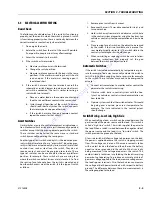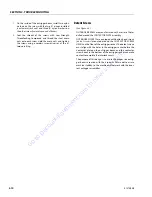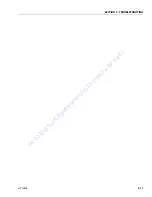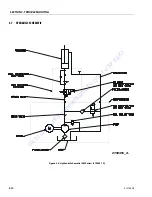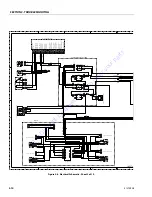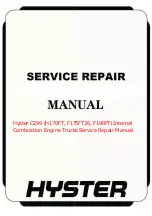
SECTION 3 - TROUBLESHOOTING
3-2
31215808
Polarity
Finding a negative voltage or current reading when expecting
a positive reading frequently means the leads are reversed.
Check what reading is expected, the location of the signal and
that the leads are connected to the device under test correctly.
Also check that the lead on the "COM" port goes to the ground
or negative side of the signal and the lead on the other port
goes to the positive side of the signal.
Scale
M = Mega = 1,000,000 * (Displayed Number)
k = kilo = 1,000 * (Displayed Number)
m = milli = (Displayed Number) / 1,000
μ = micro = (Displayed Number) / 1,000,000
Example: 1.2 k
= 1200
Example: 50 mA = 0.05 A
Continuity Measurement Over Long Distances
When trying to determine continuity of a harness or wire, lon-
ger than the reach of standard instrument leads, is possible to
perform the check without excessively long leads. Using the
other wires in the harness one can determine the condition of
a particular wire in the harness.
Requirements:
• Harness with at least three separate wires including the
wire under test.
• These wires must be able to be isolated from other wires,
etc.
• Jumper or method to connect contacts on one side of har-
ness.
• Meter that can measure resistance or continuity.
Procedure
Test multimeter leads resistance. Subtract this value from the
measured resistance of the wires to get a more accurate mea-
surement.
Consult the circuit schematic to determine which wires to use
in addition to wire under test, here called wire #1 and wire #2,
and how to isolate these wires. These wires should appear in
the same connectors as the wire under test or are within reach
of the jumper.
1.
Disconnect all connections associated with the wire
under test and the two additional wires. If harness is not
completely isolated disconnect battery terminals also,
as a precaution.
2.
Measure continuity between all three wires, the wire
under test, wire #1 and wire #2. These should be open. If
not, repair the shorted wires or replace the harness.
3.
On one side, jumper from contact of wire #1 and wire #2.
4.
Measure continuity between wire #1 and wire #2. If
there is continuity, both wires are good and can be used
for this test. If there is not continuity, either wire could
be bad. Check connections and measurement setup.
Redo measurement. If still no continuity, repair wires or
consult schematic for other wires to use for test.
5.
Jumper from wire under test to wire #1.
6.
Measure continuity. If there is continuity, the wire under
test is good. Resistance of a wire increases as the length
increases and as the diameter decreases.
One can find the continuity of two wires, here #1 and #2, at
once by following steps 1 through 4. If there is a problem the
third wire is used to troubleshoot the other wires. To find the
problem, start at step 1 and use the entire procedure.
Go
to
Discount-Equipment.com
to
order
your
parts


















